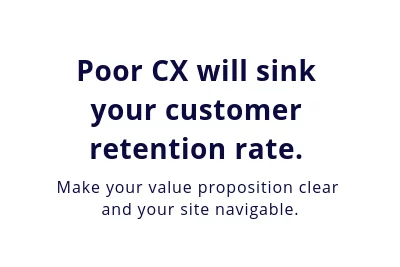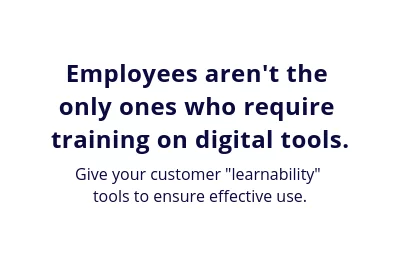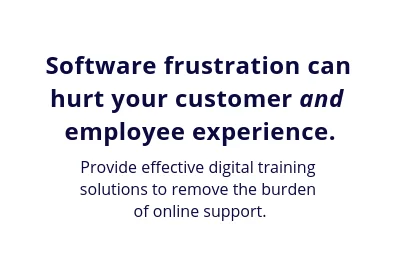[vc_row][vc_column][vc_column_text]
This is the year of the customer. According to most company decision-makers, the customer experience is the most exciting opportunity to improve business in 2019, a Digital Marketing Trends survey found.
This comes as no surprise, as 86% of consumers are willing to pay more for a great customer experience.
As companies pour more effort and investments into digital transformation, the customer experience also undergoes changes. In a rapidly evolving digital landscape, customers may encounter friction with digital tools and interfaces that leave them feeling dissatisfied with brand interactions.
And unlike employees, who are vested in the company and trained to use new technology, customers who have negative experiences won’t hesitate to click away from a site that isn’t user-friendly.
More than 80% of companies recognize customer experience (CX) as a competitive differentiator, but only 13% rate their own CX delivery at a nine out of 10 or better. Creating an easy-to-navigate, seamless online experience for your customers is critical to the success of your digital transformation.
 just one bad experience.
Not only that, but 67% of customers mention bad experiences as a reason for churn. Only one in 26 unhappy customers complain — the other 25 simply leave. Consider that your website or app has about 15 seconds to show value. If the user interface is difficult to understand, you’ll quickly lose that customer to a competitor.
In the past, behind the scenes changes to digital systems were essentially invisible to customers. A modification in the way a company’s website worked would have no bearing on the user experience. But today, a company’s digital appearance is a fundamental component of the overall brand.
The skill and comfort level customers have using your apps and website either support or detract from your brand image.
just one bad experience.
Not only that, but 67% of customers mention bad experiences as a reason for churn. Only one in 26 unhappy customers complain — the other 25 simply leave. Consider that your website or app has about 15 seconds to show value. If the user interface is difficult to understand, you’ll quickly lose that customer to a competitor.
In the past, behind the scenes changes to digital systems were essentially invisible to customers. A modification in the way a company’s website worked would have no bearing on the user experience. But today, a company’s digital appearance is a fundamental component of the overall brand.
The skill and comfort level customers have using your apps and website either support or detract from your brand image.
 some might be quick to adapt, many are more likely to become easily frustrated — which can result in the loss of those customers to competitors that are equipped with a more intuitive user interface (UI).
Enabling all of your current and potential customers to become competent users of your website is critical to success. A recent Crazy Egg study found that poor “learnability” drives users away from your site. Ensuring that your customers can easily navigate your website improves the probability that they’ll return. Investing in proper training tools can help to ease the customer journey.
some might be quick to adapt, many are more likely to become easily frustrated — which can result in the loss of those customers to competitors that are equipped with a more intuitive user interface (UI).
Enabling all of your current and potential customers to become competent users of your website is critical to success. A recent Crazy Egg study found that poor “learnability” drives users away from your site. Ensuring that your customers can easily navigate your website improves the probability that they’ll return. Investing in proper training tools can help to ease the customer journey.
 experience. What’s more, depending on their comfort level with technology, the CSR may not have the training required to appropriately assist these customers, leading to even more frustration from both the customer and the employee.
The right technology can remove the burden of application or website support from the customer service rep and help to lower customer support costs and improve experiences.
experience. What’s more, depending on their comfort level with technology, the CSR may not have the training required to appropriately assist these customers, leading to even more frustration from both the customer and the employee.
The right technology can remove the burden of application or website support from the customer service rep and help to lower customer support costs and improve experiences.
Bring your digital vision to life with a DAP. Discover why transformational CIOs turn to WalkMe.
That said, there are several customer-focused roadblocks to overcome.Customer challenge #1: Low tolerance levels
Customers’ attention spans are short. A recent PwC survey found that one in three customers leave a brand they love after just one bad experience.
Not only that, but 67% of customers mention bad experiences as a reason for churn. Only one in 26 unhappy customers complain — the other 25 simply leave. Consider that your website or app has about 15 seconds to show value. If the user interface is difficult to understand, you’ll quickly lose that customer to a competitor.
In the past, behind the scenes changes to digital systems were essentially invisible to customers. A modification in the way a company’s website worked would have no bearing on the user experience. But today, a company’s digital appearance is a fundamental component of the overall brand.
The skill and comfort level customers have using your apps and website either support or detract from your brand image.
just one bad experience.
Not only that, but 67% of customers mention bad experiences as a reason for churn. Only one in 26 unhappy customers complain — the other 25 simply leave. Consider that your website or app has about 15 seconds to show value. If the user interface is difficult to understand, you’ll quickly lose that customer to a competitor.
In the past, behind the scenes changes to digital systems were essentially invisible to customers. A modification in the way a company’s website worked would have no bearing on the user experience. But today, a company’s digital appearance is a fundamental component of the overall brand.
The skill and comfort level customers have using your apps and website either support or detract from your brand image.
Customer challenge #2: Wasting time
Respecting customers’ time is a top-five issue for enhancing the customer experience, according to Forbes. Few things consume a customer’s time more than an impenetrable, frustrating website. Even worse, many companies require customers to call a customer service rep (CSR) when they have an issue. Forcing a customer to stop what they’re doing and call a CSR creates an interruption and costs the customer additional time. Without a seamless omnichannel experience, customers are often forced to repeat their issue to multiple representatives, adding to more frustration and additional time wasted.Customer challenge #3: Comfort with technology
When it comes to technology, customers have a wide range of experiences, capabilities, and interface preferences. While some might be quick to adapt, many are more likely to become easily frustrated — which can result in the loss of those customers to competitors that are equipped with a more intuitive user interface (UI).
Enabling all of your current and potential customers to become competent users of your website is critical to success. A recent Crazy Egg study found that poor “learnability” drives users away from your site. Ensuring that your customers can easily navigate your website improves the probability that they’ll return. Investing in proper training tools can help to ease the customer journey.
some might be quick to adapt, many are more likely to become easily frustrated — which can result in the loss of those customers to competitors that are equipped with a more intuitive user interface (UI).
Enabling all of your current and potential customers to become competent users of your website is critical to success. A recent Crazy Egg study found that poor “learnability” drives users away from your site. Ensuring that your customers can easily navigate your website improves the probability that they’ll return. Investing in proper training tools can help to ease the customer journey.
Customer challenge #4: Outdated training tools
Unfortunately, the vast majority of organizations rely on outdated tools, such as interactive chat and simple help glossaries, that fail to move the needle. These approaches are limited in scope and only effective in serving a small percentage of customers. It’s also worth noting that 70% of customers expect a company’s website to offer self-service applications. In fact, Gartner predicts that by 2020, customers will manage 85% of their relationship with an organization without ever interacting with a human.Customer challenge #5: CSRs who aren’t trained to train
Forcing customers to move their focus from the website to call or chat with a CSR can lead to a negative customer experience. What’s more, depending on their comfort level with technology, the CSR may not have the training required to appropriately assist these customers, leading to even more frustration from both the customer and the employee.
The right technology can remove the burden of application or website support from the customer service rep and help to lower customer support costs and improve experiences.
experience. What’s more, depending on their comfort level with technology, the CSR may not have the training required to appropriately assist these customers, leading to even more frustration from both the customer and the employee.
The right technology can remove the burden of application or website support from the customer service rep and help to lower customer support costs and improve experiences.

